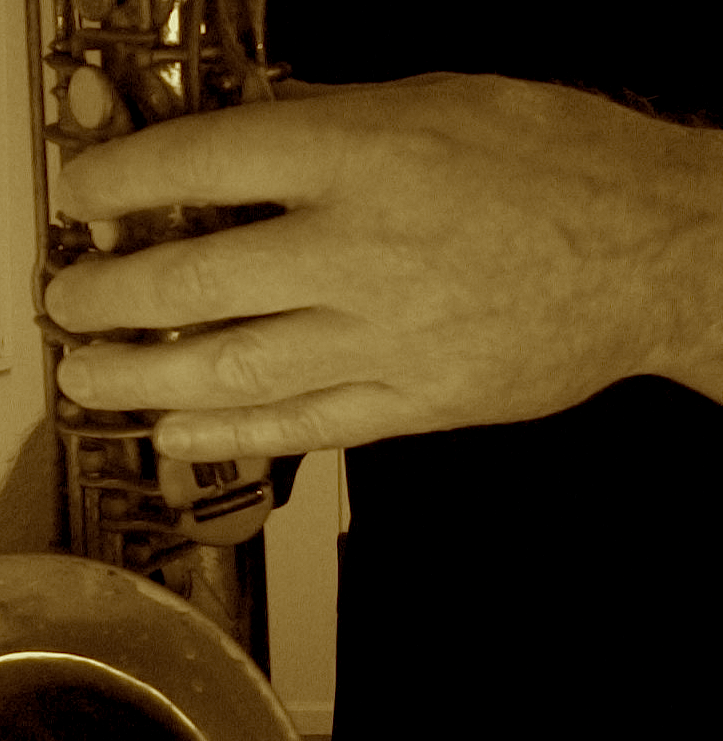Some years back, after I’d been studying the[ for a couple of years, a friend of mine, George McMullen (a highly accomplished trombonist), came to hear me play saxophone at a concert in West Los Angeles. He hadn’t heard me play in quite a while (since before I started studying the Alexander Technique).
After the concert ended, George came to talk to me and said, “You’re sounding great, but very different from the last time I heard you play. What are you doing differently?”
I remember answering him, spontaneously and without hesitation, “The real difference in my playing is not because of what I’m doing. It’s because of what I’m not doing.”
And that’s about as truthful as I could be. You see, what I wasn’t doing anymore was playing with all my old habits of tension: I wasn’t tightening my neck as I pulled my head back and down into my shoulders. I wasn’t tightening my left shoulder as I pulled my arms in toward my rib cage. I wasn’t thrusting my pelvis forward. I wasn’t locking my knees. I wasn’t clenching my jaw to produce my sound.
I was playing well, playing better than before, because of the sum total of what I wasn’t doing. F.M. Alexander (the founder of the Alexander Technique) said, “If you can stop doing the wrong thing, the right thing will do itself.” This turns out to be especially true in the act of playing music.
By playing my saxophone without my habits of tension, I become free to play in such a way that is in concert with my human design. I Become free to direct my energies most efficiently toward the act of producing a sound, and otherwise playing my instrument. And the results, as my friend could hear, are palpable.
And as I continue to teach the Alexander Technique I’m rewarded with seeing remarkable improvements in musicians as they learn the art of non-doing. Practically any musician, on any instrument (including voice) can improve how they perform by following this principle.
An example that comes to mind most recently is my experience teaching a young violist who plays in the local youth symphony. He came to me (as do an alarmingly growing number of young musicians) because of chronic tension and pain. His condition was worsening to the point that he couldn’t practice more than a few minutes without experiencing rather significant pain and muscular exhaustion.
As I observed his playing in our first lesson, I could see the manifestations of the tension that was causing his problems: stiff neck with his head pulled forcefully downward onto his instrument; left shoulder being pulled tightly upward and inward (impinging the muscles at the shoulder joint); breath being held; torso being twisted and held rigidly too far back; knees locked as his legs stiffened.
Though these are different things to observe, they’re all really part of one entire pattern of tension that is brought about by my student’s reaction to the thought of playing his instrument.
So I proceeded to help him the same way I helped myself (through the principles of the Alexander Technique). I helped him to become aware of all the unnecessary “doing” he was bringing into his playing (tension!), then I taught him how to change his thinking so he could stop doing so much (playing without so much tension and misdirected effort).
This is a process that takes persistence and time to make lasting changes. (But lasting changes are made!) He has to keep coming back to his tendency to go into his habit of tension, then make a conscious decision to not indulge in his habit as he proceeds to play his instrument. Simple in principle, but not always immediately easy to carry out. Again, persistence and time.
It’s been a few months since I started working with this student, and already things are much better for him. No more shoulder pain. No more neck pain. No more exhaustion. And what makes it all even better, is that his sound, intonation, technique and even his artistic expression have all noticeably improved.
So at our last lesson, in which my student was playing particularly well (easily, expressively, joyfully), I asked him if he could tell me what is different about how he was playing now in contrast to how he played before taking lessons with me. He, too, without hesitation answered with a list of things he wasn’t doing anymore: “I’m not scrunching my neck; I’m not pinching my left shoulder; I’m not twisting my body downward; I’m not locking my knees…” And so on.
He (like I was/am in my Alexander learning process), was very clear about why he improved, and that improvement had a great deal to do with non-doing. When he stops doing the wrong thing, beautiful, expressive, easy music is free to come forth.
And that’s the way it always is with musicians (and non-musicians) who study the Alexander Technique. They become very clear at why they are improving, at what they’re not doing anymore.
So if you notice yourself playing with great effort, notice yourself stiffening up as you play, feel blocked expressively, feel unstable as you make music, or lack confidence in your playing, consider the idea of non-doing. Notice what kinds of tension you begin to create in yourself as you go to play, and simply ask yourself if it helps you play better, or interferes with your playing.
Understand that all the the necessary skills to play your instrument well are already there, waiting latently. All you have to do is stop doing the things that interfere with this skill.
Of course, you can be greatly helped with this by a skilled Alexander Technique teacher. Consider taking a series of lessons from a qualified teacher. Allow yourself to discover the value of non-doing, and experience the possibility of positive change.
